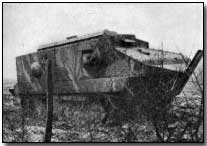Battles - The Second Battle of the Aisne, 1917
 The Second Battle of the Aisne, which comprised the main action of the Nivelle Offensive, was a virtually unmitigated disaster for the French Army. A hugely costly
attack, ultimately involving 1.2 million troops and 7,000 guns, it achieved little in the way of territorial gain - certainly not the 48 hour
breakthrough envisaged - and also brought to an end the career of its instigator, the French Commander-in-Chief Robert Nivelle, and sparked widespread mutiny in the army.
The Second Battle of the Aisne, which comprised the main action of the Nivelle Offensive, was a virtually unmitigated disaster for the French Army. A hugely costly
attack, ultimately involving 1.2 million troops and 7,000 guns, it achieved little in the way of territorial gain - certainly not the 48 hour
breakthrough envisaged - and also brought to an end the career of its instigator, the French Commander-in-Chief Robert Nivelle, and sparked widespread mutiny in the army.
Devised upon his appointment as Commander-in-Chief in December 1916, replacing Joseph Joffre, Nivelle's plan, which he confidently assured the French government would bring about an end to the war within two days, was beset by delays and leaks. By the time of its main launch on 16 April 1917, the plans were well-known to the German Army, who accordingly took appropriate defensive steps.
Nivelle's strategy by no means received unanimous support among influential French politicians. Whilst Prime Minister Briand's support effectively sanctioned the plan, it led to the resignation of war minister Hubert Lyautey. The British Commander-in-Chief, Sir Douglas Haig, expressed his opposition, as did Nivelle's successor as Commander-in-Chief, Henri-Philippe Petain. Even Nivelle's Reserve Army Group commander, General Micheler, was opposed.
19 divisions of the French Fifth and Sixth Armies - under Mazel and Mangin - went into battle on 16 April 1917, along an 80 km front from Soissons to Reims, after a week of diversionary attacks by the British in Arras.
 Opposite the French on high ground, heavily defended and fortified, was von
Boehm's German Seventh Army, who conducted an efficient defence. On 16 April
the French suffered 40,000 casualties alone, a similar disaster to that
suffered by the British on the first day of the Somme a year earlier on 1
July 1916. The mass use of French Char Schneider
tanks brought little
advantage, with 150 lost on the first day.
Opposite the French on high ground, heavily defended and fortified, was von
Boehm's German Seventh Army, who conducted an efficient defence. On 16 April
the French suffered 40,000 casualties alone, a similar disaster to that
suffered by the British on the first day of the Somme a year earlier on 1
July 1916. The mass use of French Char Schneider
tanks brought little
advantage, with 150 lost on the first day.
On the second day the French Fourth Army under Anthoine launched a subsidiary attack east of Reims towards Moronvilliers. However von Below's German First Army readily repelled the assault.
Ironically, in the attacks of 16 and 17 April Nivelle's own innovation - the creeping barrage - was incorrectly deployed, leading to increased French casualties as the infantry advanced without protection.
Despite evidence to the contrary, Nivelle believed his offensive would ultimately prove successful, continuing French attacks until 20 April. Some gains were made, by Mangin west of Soissons, but progress was slow. The offensive was scaled back over the next two weeks, although by 5 May a 4 km stretch of the Chemin des Dames Ridge - part of the Hindenburg Line - had been captured. The offensive was finally abandoned in disarray on 9 May following a final ineffective four day assault.
French losses were significant, with 187,000 casualties. The Germans suffered an estimated 168,000 losses.
At home, disillusion among French public and politicians alike led to Nivelle's prompt removal, replaced on 25 April by the considerably more cautious Henri-Philippe Petain. Petain was only able to restore order within the French Army by improving trench conditions and, more importantly, by refraining from committing his forces to offensive operations.
Click here to view a map of Nivelle's preparations for the battle; click here to view a map charting the battle's progress.
Photographs courtesy of Photos of the Great War website
Click here to read the reaction of Kaiser Wilhelm II to news of German success; click here to read Erich Ludendorff's view; click here to read the account given by the French War Minister Paul Painleve.
Bulgaria mobilised a quarter of its male population during WW1, 650,000 troops in total.
- Did you know?
